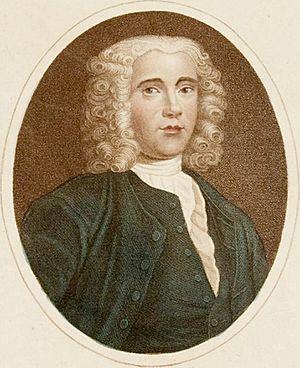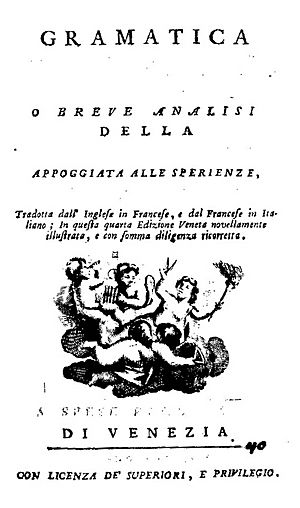Benjamin Martin (lexicographer) facts for kids
Quick facts for kids
Benjamin Martin
|
|
|---|---|
 |
|
| Born | 1704 (date of baptism) Worplesdon, Surrey
|
| Died | 9 February 1782 London
|
| Nationality | British |
| Occupation | lexicographer |
Benjamin Martin (baptized 1705; died 1782) was a very smart British man who lived a long time ago. He was known for many things! He created one of the first English dictionaries, called the Lingua Britannica Reformata, in 1749. He also taught about science and made cool scientific tools.
Contents
Benjamin Martin's Life Story
Benjamin Martin was born in Worplesdon, Surrey. He started his life working as a ploughboy, which meant he helped with farming. But he was very clever and soon became a teacher.
A gift of £500 (which was a lot of money back then!) helped him buy many books and scientific tools. This allowed him to become a popular lecturer, teaching people about science. He was a big supporter of Isaac Newton's ideas about how the world works. In 1737, he wrote a book called Bibliotheca Technologica, which was a big survey of natural philosophy, or science.
Moving to London
Around 1740, Benjamin Martin moved to Fleet Street in London. This was a great spot because it was near the Royal Society, where his hero, Newton, often gave talks.
He started making scientific instruments, like the Hadley's quadrant. This tool was used by sailors to figure out their position at sea, a bit like an early sextant. He also made optical instruments, like lenses and telescopes. His business did very well, and he became famous for making eyeglasses too!
He kept giving lectures on natural philosophy. From 1755 to 1764, he published Martin's Magazine. This magazine was like an encyclopedia, giving readers bits of knowledge about different subjects each month. He hoped people would collect all the parts and bind them into one big reference book. He also wrote The Natural History of England, which described the interesting natural and artistic things in each county of England.
Sadly, in 1781, when he was 77 years old, Benjamin Martin's business ran into trouble and he went bankrupt. He had given control of his business to some managers who weren't very good at their job.
His Famous Dictionary
In 1749, Benjamin Martin published his dictionary, called Lingua Britannica Reformata, Or, A New English Dictionary.
How the Dictionary Was Made
His dictionary included a lot of information from an earlier dictionary by Nathan Bailey, published in 1721. Benjamin Martin thought Bailey's dictionary was "the best English dictionary" at the time. Bailey's dictionary had also borrowed heavily from an even older dictionary by Edward Phillips and John Kersey from 1706. A second version of Martin's dictionary came out in 1754, just one year before Samuel Johnson published his very famous dictionary.
Language Changes Over Time
When Benjamin Martin was putting together his dictionary, which had about 24,500 words, he realized something important about language. He wrote:
- The idea of making a language stay the same forever is completely pointless. This is because language depends on how people use it, and it will always be changing. What seems polite and elegant in one time might seem old-fashioned or strange in another.
This idea, that language is always changing, was also shared by Samuel Johnson. It's now the accepted way that people who study dictionaries (called lexicographers) think about language. Martin's dictionary also set out clear goals for what a dictionary should do, like explaining word origins.
While his explanations of word origins (called etymologies) were sometimes a bit mixed up and often favored Latin roots, his dictionary was still better than earlier ones. It had a simpler way of spelling words and a clearer guide to how words should be said.


